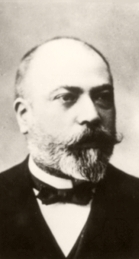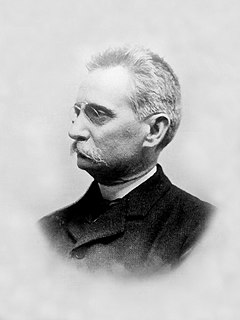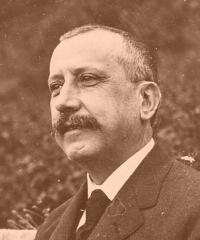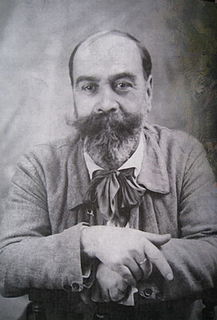 W
WThe banner of Misericordia (Mercy) is a work of the Catalan architect Antoni Gaudí projected for the procession to the Sanctuary of Misericordia in Reus of the reusians residing in Barcelona, as one of the acts for the 1900 Holy Year. It is known by the two front and back photographs published in the Semanario Católico de Reus in July of that year. It included another photograph of the procession in which Gaudí is seen as part of a large group of pilgrims and the banner being carried by one of them.
 W
WFrancesc Berenguer i Mestres was a Spanish Modernista architect from Catalonia, and an assistant and friend of Antoni Gaudí.
 W
WJaume Busquets i Mollera was a Spanish sculptor and painter of the noucentisme generation from Catalonia.
 W
WRamón Casas i Carbó was a Spanish artist. Living through a turbulent time in the history of his native Barcelona, he was known as a portraitist, sketching and painting the intellectual, economic, and political elite of Barcelona, Paris, Madrid, and beyond; he was also known for his paintings of crowd scenes ranging from the audience at a bullfight to the assembly for an execution to rioters in the Barcelona streets. Also a graphic designer, his posters and postcards helped to define the Catalan art movement known as modernisme.
 W
WJosep Domènech i Estapà was a Catalan architect.
 W
WLluís Domènech i Montaner was a Spanish architect who was highly influential on Modernisme català, the Catalan Art Nouveau/Jugendstil movement. He was also a Catalan politician.
 W
WAntoni Gaudí i Cornet was a Catalan architect known as the greatest exponent of Catalan Modernism. Gaudí's works have a highly individualized, sui generis style. Most are located in Barcelona, including his main work, the church of the Sagrada Família.
 W
WJosep Maria Jujol i Gibert was a Catalan architect. Jujol's wide field of activity ranged from furniture designs and painting, to architecture. He worked with Antoni Gaudí on many of his most famous works. Among Jujol's projects are Casa Batlló, Casa Milà, Park Güell, and Our Lady of Montserrat, and among his design styles are Modernisme and Art Nouveau.
 W
WJoan Maragall i Gorina was a Catalan poet, journalist and translator, the foremost member of the modernisme movement in literature. His manuscripts are preserved in the Joan Maragall Archive of Barcelona.
 W
WCèsar Martinell i Brunet was a Catalan modernista architect. He was part of the small and selected group of architects that were connected to Antoni Gaudí, his most important teacher. As a multifaceted person, Martinell was also a researcher and art historian. He became famous for the many wine cellars he made for the agriculture cooperatives of different towns throughout Catalonia, especially in the south, in the Province of Tarragona. These are known as "the cathedrals of wine".
 W
WJoan Martorell i Montells was a Catalan architect and designer. He was an uncle of the architect Bernardí Martorell i Puig.
 W
WRafael Masó i Valentí was one of the most outstanding Catalan architects of the early 20th century. Masó was born in Girona into a refined, conservative, Catholic family of Catalanist ideology. The personality and professional career of the future architect were marked by the cultured atmosphere of his home, created by his father’s literary and artistic interests, as well as his own love of Girona city and its traditions. Masó was an admirer of Antoni Gaudí but, as a student in Barcelona, he joined the group of artists and writers who were to forge Noucentisme, the movement that developed as an alternative to Modernisme. The civic spirit, the Catalanist outlook, and the forward-looking, pro-European ideas prevailing within the new movement inspired the young Masó, who was also to become a distinguished poet, urban planner, politician, and promoter of art and literature.
 W
WEnrique Nieto y Nieto was a Spanish architect known for his Modernisme style, which he continued to receive commissions to design even after it fell out of favor. He was a student of Antoni Gaudí and followed his master's style when he designed noted projects in Barcelona and Melilla. In 1939, he was appointed city architect of Melilla, a Spanish enclave in North Africa. Mellila's collection of modernisme-style buildings constitutes the second largest concentration of representatives of the style outside of Barcelona.
 W
WJosep Puig i Cadafalch was a Catalan Spanish Modernista architect who designed many significant buildings in Barcelona, and a politician who had a significant role in the development of Catalan institutions. He was the architect of the Casa Martí, which became a place of ideas, projects and social gatherings for such well-known Catalans as Santiago Rusiñol and Ramon Casas.
 W
WSalvador Valeri i Pupurull (1873–1954) was a Catalan architect who worked in the style of Modernisme.
 W
WJoan Rubió y Bellver was a Spanish architect famous for his contributions to the Catalan Modernista movement.
 W
WEnric Sagnier i Villavecchia was a Spanish architect.
 W
WDomènec Sugrañes i Gras was a Catalan modernist architect and disciple of Antoni Gaudí. He succeeded him at the head of the works of the church of the Sagrada Família and finished the façade of the Nativity. Sugrañes held this charge during 10 years, from Gaudí's death in 1926 until 20 July 1936.
 W
WJoaquin Mir Trinxet or Joaquin Mir y Trinxet was a Spanish artist known for his use of color in his paintings. He lived through a turbulent time in the history of his native Barcelona. His paintings helped to define the Catalan art movement known as modernisme.
 W
WJosep Vilaseca i Casanovas was a Catalan architect and artist who formed part of the Modernista movement.